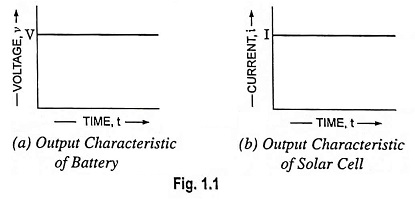Types of Power Supply in Electronics:
There are two types of Power Supply in Electronics viz. dc supply and ac supply.
The voltage or current available from batteries or solar cells is direct in the sense that the polarity remains the same. Such sources are called direct current sources. A plot of output of such sources with respect to time is a straight line parallel to time axis as illustrated in Fig. 1.1. This shows that the voltage / current output of a dc source is constant with respect to time, unless the chemicals in the battery are exhausted or the light incident on solar cell varies.
Power obtainable from batteries or solar cells is very small as compared to the total power we need. The dc power in bulk can be generated by using dc generators. Standard dc voltages are 230 and 460 V.
A current (or voltage) is called alternating if it periodically changes its direction and magnitude whereas direct currents are steady and in one direction. In more restricted sense, alternating current is a periodically varying current, the average value of which, over a period, is zero.
At present a large percentage of electrical energy (nearly all) being used for domestic, commercial and industrial purposes is generated as alternating current because of technical and economical reasons.
In our country the standard voltage for low tension (lt) distribution is 240/415 V (240 V between phase and neutral wires and 415 V from line-to-line). This is a reasonably safe voltage. Higher the voltage used, lower is the installation cost i.e. economy is achieved but increase of voltage means more hazard to human life and property. Hence, a compromise is made. All over the world the standard voltage used for lt distribution is in the range of 200/350 V to 250/440 V except in American continent where 110/190 V is the distribution voltage. Generation, transmission and ht distribution voltages are governed by economy and operation.
